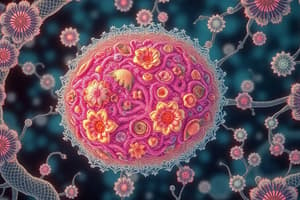Podcast
Questions and Answers
Which type of viral infection involves the virus remaining dormant within the host and later reactivating?
Which type of viral infection involves the virus remaining dormant within the host and later reactivating?
- Lytic infection
- Oncogenic infection
- Acute infection
- Latent infection (correct)
What distinguishes prions from other infectious agents?
What distinguishes prions from other infectious agents?
- They are larger in size than viruses
- They are resistant to destruction by cooking (correct)
- They infect only plants
- They contain both proteins and nucleic acids
Which virus is an example of an oncogenic infection that can lead to cancer?
Which virus is an example of an oncogenic infection that can lead to cancer?
- Hepatitis A virus
- Influenza virus
- Herpes simplex virus
- Human papillomavirus (HPV) (correct)
How do vaccinations and antiviral drugs differ in combating viral infections?
How do vaccinations and antiviral drugs differ in combating viral infections?
What is the primary route of transmission for plant viroids?
What is the primary route of transmission for plant viroids?
What is a key difference between the lytic and lysogenic cycles of bacteriophage replication?
What is a key difference between the lytic and lysogenic cycles of bacteriophage replication?
How do plant viruses overcome the challenge of the cell wall barrier during transmission?
How do plant viruses overcome the challenge of the cell wall barrier during transmission?
Which type of viral infection involves integration of viral DNA into the host cell's chromosome before potentially entering the lytic cycle?
Which type of viral infection involves integration of viral DNA into the host cell's chromosome before potentially entering the lytic cycle?
How do horizontally transmitted plant viruses differ from vertically transmitted plant viruses?
How do horizontally transmitted plant viruses differ from vertically transmitted plant viruses?
What is a common method of animal virus transmission that differs from plant virus transmission?
What is a common method of animal virus transmission that differs from plant virus transmission?
Which kingdom is most closely related to fungi?
Which kingdom is most closely related to fungi?
Among the given examples, which protist is responsible for causing malaria in humans?
Among the given examples, which protist is responsible for causing malaria in humans?
What is the primary role of protists in aquatic environments?
What is the primary role of protists in aquatic environments?
Which fungal-like protist is known to cause blights, including the one responsible for the Irish potato famine?
Which fungal-like protist is known to cause blights, including the one responsible for the Irish potato famine?
Which protist can lead to African sleeping sickness in humans?
Which protist can lead to African sleeping sickness in humans?
How do prokaryotes participate in the carbon cycle?
How do prokaryotes participate in the carbon cycle?
What is the primary role of prokaryotes in the nitrogen cycle?
What is the primary role of prokaryotes in the nitrogen cycle?
Why do natural reservoirs make disease eradication challenging?
Why do natural reservoirs make disease eradication challenging?
What can lead to the creation of 'super bugs'?
What can lead to the creation of 'super bugs'?
How do biofilms contribute to the spread of diseases?
How do biofilms contribute to the spread of diseases?
What is the main difference between the lytic cycle and the lysogenic cycle?
What is the main difference between the lytic cycle and the lysogenic cycle?
How are plant viruses typically transmitted?
How are plant viruses typically transmitted?
What distinguishes a latent viral infection from an oncogenic viral infection?
What distinguishes a latent viral infection from an oncogenic viral infection?
How are animal viruses primarily transmitted between hosts?
How are animal viruses primarily transmitted between hosts?
What is a key difference between how lytic cycle viruses and lysogenic cycle viruses infect host cells?
What is a key difference between how lytic cycle viruses and lysogenic cycle viruses infect host cells?
What is the main difference between primary endosymbiosis and secondary endosymbiosis?
What is the main difference between primary endosymbiosis and secondary endosymbiosis?
What is the key evidence supporting the endosymbiotic theory regarding the origin of eukaryotic cells?
What is the key evidence supporting the endosymbiotic theory regarding the origin of eukaryotic cells?
Which supergroup of eukaryotes are plants related to based on evolutionary relationships?
Which supergroup of eukaryotes are plants related to based on evolutionary relationships?
What is a distinguishing characteristic of protists in terms of their metabolic diversity?
What is a distinguishing characteristic of protists in terms of their metabolic diversity?
How do latent viral infections differ from oncogenic viral infections?
How do latent viral infections differ from oncogenic viral infections?
What type of viruses are capable of integrating their genome into the host cell's DNA and remain dormant?
What type of viruses are capable of integrating their genome into the host cell's DNA and remain dormant?
Which cycle involves the viral DNA becoming integrated into the host cell's DNA without causing immediate harm?
Which cycle involves the viral DNA becoming integrated into the host cell's DNA without causing immediate harm?
How do plant viruses primarily spread among plants?
How do plant viruses primarily spread among plants?
Which term is used to describe viruses that have the potential to cause cancer?
Which term is used to describe viruses that have the potential to cause cancer?
How are animal viruses typically transmitted between hosts?
How are animal viruses typically transmitted between hosts?
Which process involves the destruction of the host cell for viral replication and release?
Which process involves the destruction of the host cell for viral replication and release?
What important characteristic of retroviruses distinguishes them from other types of viruses?
What important characteristic of retroviruses distinguishes them from other types of viruses?
What is a common mode of transmission for animal viruses causing respiratory illnesses?
What is a common mode of transmission for animal viruses causing respiratory illnesses?
Which type of virus is known for causing cold sores in humans by establishing a latent infection in nerve cells?
Which type of virus is known for causing cold sores in humans by establishing a latent infection in nerve cells?
How do prions differ from typical viruses in terms of their structure and replication mechanism?
How do prions differ from typical viruses in terms of their structure and replication mechanism?
Flashcards are hidden until you start studying




